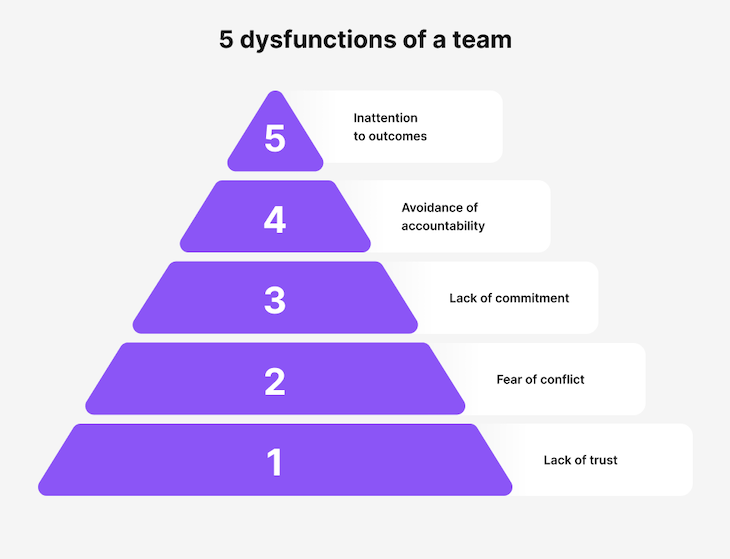To build great products, you need great teams.

One of the primary jobs of a leader — whether a formal or informal one — is to ensure that the team doesn’t develop dysfunctions that hinder the team’s progress toward achieving peak performance.
In this article, you will learn what the five major dysfunctions for teams are and how to prevent them from damaging your team.
The concept of team dysfunctions was popularized by Patrick Lencioni in Five Dysfunctions of a Team, published in 2002.
He named five primary dysfunctions:
These can be reflected in the form of a pyramid:

In this case, a pyramid makes sense because dysfunctions are interdependent and live on top of each other.
That means you can’t fully eliminate a particular dysfunction if you don’t first address the preceding dysfunctions.
For example, you won’t cure a lack of commitment without first addressing the fear of conflict in the team, and the first step to get rid of this fear is by tackling a lack of trust.
Now, let’s dig deeper into each dysfunction to understand what they are and what we can do to eliminate them:
Although it might sound cliche, bear with me.
There are various types of trust. When we talk about trust in the workplace, we usually mean predictive trust.
Predictive trust develops naturally over time and is based on trusting that others can deliver on what they promise. For example, if you worked with a particular designer long enough, at some point, you trust that they’ll meet their deadlines.
The bigger issue is the lack of vulnerability-based trust.
This is the type of trust that allows you to fully open yourself and express your thoughts without being judged or scorched.
You know this type of trust exists when each team member feels comfortable saying things like:
Once you unlock this level of trust, team dynamics change entirely.
The first step to avoid this dysfunction is for the leader to go first. Be honest with your vulnerabilities and admit whenever you make a mistake.
The old business school of thought often teaches that you “shouldn’t let people see you sweat”. But the truth is, people who work closely with you know when you sweat before you do.
You need to set an example that being vulnerable is not only okay, but desired and appreciated.
You must also invest a lot of time in one-on-one interaction. It’s often extremely difficult for new team members to be vulnerable with the whole group at first. If you build personal relationships with them, they might find it easier to open up in front of you, and that’s a solid first step.
There are two types of conflict: meaningless and productive.
Meaningless conflict occurs when people fight about unimportant issues or trash-talk each other. On the other hand, productive conflict allows people to engage in disagreements around serious issues.
The second type of conflict is good, and it’s especially critical during the storming stage of team development.
And for a conflict to be productive, people mustn’t hold back.
Some might say that a conflict is mean, but conflict isn’t mean. Holding back is mean.
Imagine you disagree with someone but don’t show it to avoid hurting someone’s feelings. What often happens next is that you question the decision in your head and maybe even open up to some coworkers about how much you disagreed with the opinion.
If other people do the same, you end up in a situation where everyone was happy during the meeting, but has negative thoughts afterward.
As a result, you crushed your coworker’s reputation, and if they realize it after the fact, also their spirit. If we truly respect our colleagues, we owe it to them to be honest and disagree if needed.
Vulnerability-based trust is essential for productive conflicts. If people don’t feel safe to disagree, or some people get sad and defensive when someone disagrees with them, revisit the first dysfunction.
As a leader, you should always be on the lookout for unresolved conflicts. During meetings, observe and try to feel if everyone is on the same page, and if you notice they’re not, call it out. Provoke productive conflict.
An interesting tactic is to have everyone go one by one and state, “I agree with the direction.” That often motivates people to speak up when it’s their turn and they think otherwise.
You can also sense if there are any unresolved conflicts between team members by having regular one-on-ones. These things simply can’t be hidden. Focus on coaching involved people into why they owe it to each other to unpack the topic, even if it means having an unpleasant conversation.
The team must be committed to the direction and decisions they take.
If they do the work they’re supposed to do, but deep inside they believe it’s stupid, they’ll not only quickly lose motivation, but might even unconsciously sabotage the whole initiative. This could occur by venting to other coworkers and spreading a bad atmosphere, or by not raising potential issues and risks they notice simply because they don’t care enough.
A lack of commitment usually happens when people disagree with the direction of the team.
Intel’s solution for this dysfunction is to embrace the “disagree and commit” philosophy.
Whenever a decision needs to be made, inspire conflict and encourage people to share opposing opinions. They all need to be heard. If your team avoids conflict, revisit the previous two dysfunctions.
After hearing everyone out, there still might be no solution that fully satisfies everyone. In these cases, avoid looking for consensus. Consensus usually means making a decision that everyone mutually dislikes.
If the team cannot agree on a direction, it’s your role as a leader to break the tie and make the call. That’s also the moment when you should stress that you heard and considered everyone’s opinion, but the team must proceed, and to proceed, everyone must be committed to the final decision, even if they disagree.
People will usually support a decision they disagree with if they feel their input was heard, respected, and taken into consideration.
A high-performing team holds each other accountable, and it starts with the leader keeping the team accountable in the first place.
I get it. Keeping others accountable is harder than it sounds.
Sometimes you don’t want to make a fuss about small things. Sometimes you want to avoid conflict. Sometimes you might believe intervening it’s not worth the time and effort.
If you don’t hold people accountable, they won’t keep each other accountable. After all, why would they?
On the other hand, remain strict and keep your team accountable for:
If you always bring it up when new features aren’t documented the way they should, then if a team member notices that other members are behind with the documentation, there’s a high chance they’ll remind them and push them to finish it, either because:
Keeping people accountable pushes them to improve, avoid cutting corners, and always stay on top of their game.
Inattention to outcomes occurs when the team doesn’t really care if you achieve your shared goals.
Many PMs assume that focusing on outcomes is obvious. After all, what else would they care about?
Instead, team members might prioritize their:
Inattention to results is the easiest and hardest dysfunction to fight, depending on how you look at it.
People won’t pay attention to outcomes if they don’t feel accountable for them.
When you look at it from this perspective, isn’t it funny how many PMs constantly talk about “focusing on outcomes,” as if repeating that over and over again would just cause it to happen.
Team dysfunctions can be the number one inhibitor of performance. Because of this, identifying and dealing with them is one of the most important roles of a product manager.
Be warned, though. The journey is long and challenging. Don’t think about tackling all those dysfunctions on some week-long team retreat. Sometimes it takes months to fully deal with the first one.
However, each newly handled dysfunction will inevitably result in dramatic improvements in team dynamics and productivity.
Featured image source: IconScout

LogRocket identifies friction points in the user experience so you can make informed decisions about product and design changes that must happen to hit your goals.
With LogRocket, you can understand the scope of the issues affecting your product and prioritize the changes that need to be made. LogRocket simplifies workflows by allowing Engineering, Product, UX, and Design teams to work from the same data as you, eliminating any confusion about what needs to be done.
Get your teams on the same page — try LogRocket today.

A practical five minute revenue estimation method to help product managers compare ideas, drop low impact features, and prioritize smarter.

A practical guide for PMs who want to stop being bottlenecks, delegate smarter, and lead teams effectively with a clear ownership framework.

Stop letting unreliable data block features. Treat data as inventory to track quality, ownership, and ship with confidence.

Learn why slide decks slow teams down and explore better tools like whiteboards, PRDs, and prototypes to improve collaboration and alignment.